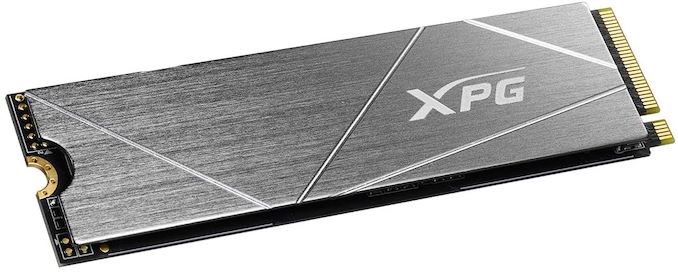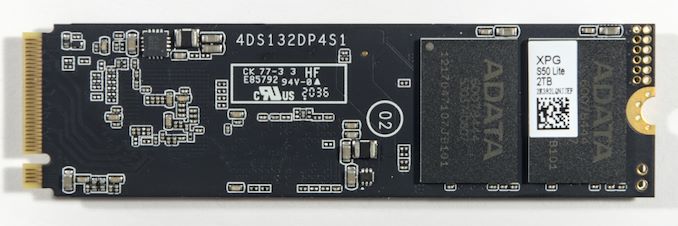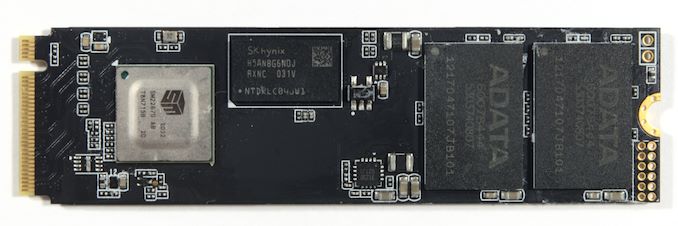The ADATA GAMMIX S50 Lite 2TB SSD Review: Mainstream PCIe Gen4
by Billy Tallis on April 30, 2021 8:00 AM EST
The roll-out of PCIe 4.0 support to consumer NVMe SSDs has been a long, drawn-out process so far, but it is progressing. Two waves of high-end SSDs have now hit the market, and last year we saw several brands introduce QLC-based SSDs using the now-outdated first-wave Gen4 SSD controller from Phison. More recently, PCIe 4.0 support has arrived for the mainstream mid-range market segment thanks to the ADATA XPG Gammix S50 Lite, based on the Silicon Motion SM2267 controller and TLC NAND flash memory.
The ADATA S50 Lite uses Silicon Motion's first PCie 4.0 SSD controller: the SM2267. Opting to start small, Silicon Motion has launched their mainstream SSD controller first, while their upcoming (overdue?) SM2264 will eventually be filling the high-end role.
To that end, the SM2267 serves Silicon Motion's lineup as a smaller, cheaper design aimed at mainstream consumer use cases. To accomplish this, Silicon Motion has built the SM2267 on a tried-and-true (and cheap) 28nm process and equipped the controller with 4 NAND channels, as opposed to the 12nm (or smaller) 8-channel controllers that are used in the latest high-end drives. This does limit maximum performance, but it also helps to keep costs in check, something that's especially useful during the current chip crunch.
Intel's recently-launched third generation QLC SSD (the Intel SSD 670p) uses a close relative of this controller; the SM2265 is an Intel-commissioned derivative of the SM2267 that lacks PCIe 4.0 support, but is otherwise identical in all the important ways. As we'll see from the S50 Lite's performance, the Intel 670p isn't missing out on much without that Gen4 support.
As for the subject of today's review, the ADATA XPG Gammix S50 Lite and its SM2267 controller is part of a growing trend of mainstream NVMe SSDs moving to 4-channel controllers rather than 8 channels. The capacity of individual NAND flash memory dies has grown to the point that an 8-channel controller is not necessary to get 2TB of flash connected, and the IO speed of recent generations of NAND flash is fast enough that a newer four-channel controller can match the performance of older 8-channel designs. This was first demonstrated to great effect by the SK hynix Gold P31. On paper, the Gammix S50 Lite promises more or less the same thing: performance that matches or slightly exceeds what we see from high-end PCIe Gen3 SSDs also using TLC NAND, despite working with half as many NAND channels.
| ADATA XPG Gammix S50 Lite Specifications | |||||
| Capacity | 512 GB | 1 TB | 2 TB | ||
| Form Factor | M.2 2280 double-sided with heatsink | ||||
| Interface | PCIe 4 x4, NVMe 1.4 | ||||
| Controller | Silicon Motion SM2267 | ||||
| NAND Flash | Intel/Micron 96L TLC | ||||
| DRAM | DDR4 | ||||
| Sequential Read (MB/s) | 3800 | 3900 | |||
| Sequential Write (MB/s) | 2800 | 3200 | |||
| Random Read IOPS (4kB) | 191k | 380k | 490k | ||
| Random Write IOPS (4kB) | 510k | 540k | |||
| Warranty | 5 years | ||||
| Write Endurance | 370 TB 0.4 DWPD |
740 TB 0.4 DWPD |
1480 TB 0.4 DWPD |
||
| Retail Price | $139.99 (14¢/GB) |
$235.99 (12¢/GB) |
|||
ADATA equips the S50 Lite with a fairly thick heatspreader, and like most of their Gammix SSDs, that heatspreader comes already attached to the drive rather than packaged separately as with their SX series drives. Instead of using their typical thermal paste, this heatspreader is attached with what is by far the most tenacious thermal tape we've ever encountered. It is reinforced with a tight-woven stiff fabric and the adhesive was strong enough that removing the heatspreader without permanently damaging the drive required copious use of solvents instead of just a bit of gentle prying.
So while we had originally speculated that the SM2267 controller might allow the S50 Lite to be the first Gen4 SSD suitable for laptop usage (hoping for similar power efficiency to the SK hynix Gold P31), this heatspreader plus the double-sided design means the S50 Lite will be a challenge to fit into some notebooks.
The SM2267 controller actually has a slightly higher pin count than the older 8-channel SM2262(EN) controllers, but the SM2267 uses denser packaging to fit in the same footprint as their earlier 4-channel SM2263 controller. The resulting PCB layout is not at all crowded, and could have easily been made into a single-sided design like the Intel 670p, had ADATA wanted to stack 16 NAND dies per package. Any future drives that use the DRAMless SM2267XT variant certainly should be single-sided.
Our 2TB S50 Lite sample is equipped with 1GB of DDR4 DRAM—half as much as we would typically expect from a mainstream or high-end SSD. As the high-end has moved on to PCIe Gen4, we have seen an increasing number of mid-range or low-end NVMe SSDs cut back from the usual 1GB per 1TB ratio of DRAM to NAND, and with the S50 Lite that trend has crossed over to Gen4. Having half or a fourth of the usual DRAM is nowhere near as serious a handicap as an entirely DRAMless SSD design, and will generally only make a difference for very storage-intense usage with heavy multitasking—workloads that are a bit beyond the intended use case for a drive like the S50 Lite.
Also noteworthy about the S50 Lite is that ADATA announced and published specs for a 512GB model, but we've only seen the 1TB and 2TB models hit the market.
The Competition
ADATA's original Gammix S50 was a Phison E16 drive: their first flagship Gen4 drive and part of the first wave of consumer Gen4 SSDs. That has since been superseded by the Gammix S70, and the S50 Lite slots into a lower position in their product stack. Standing in for the various Phison E16 TLC drives, we have test results from the Seagate FireCuda 520. We also have the Corsair MP600 CORE representing the Phison E16 QLC drive family.
Other PCIe Gen4 drives in this review include the WD Black SN850 and Samsung 980 PRO—both high-end models that are significantly more expensive.
The rest of the drives included in this review are a variety of more mainstream PCIe Gen3 SSDs and some relatively low-end NVMe options. Highlights include the Intel 670p (almost the same controller, but with QLC), the HP EX950 and Kingston KC2500 using the previous-generation SM2262EN controller, and Microcenter's Inland Premium representing the current crop of Phison E12S drives with TLC NAND and a reduced DRAM ratio.

















93 Comments
View All Comments
FunBunny2 - Wednesday, May 5, 2021 - link
"every dollar spent on QLC is a dollar not spent on TLC -- nor MLC."it's been ages since I looked, but I'd wager that not even Enterprise RDBMS Storage Appliances are built with SLC any more. where did it all go? :)
Oxford Guy - Thursday, May 6, 2021 - link
SLC is an extreme example for most workloads. MLC is a far more enlightening one for consumers, as is the transition from planar to 3D TLC.Wereweeb - Saturday, May 1, 2021 - link
That is not economies of scale, that is market share. What you want is not to make TLC cheaper, but to boycott QLC.I wouldn't have disagreed with you when QLC came out. But right now I'd consider it good enough for most consumers, regardless of it being technically inferior to TLC.
The truth is, there just isn't any real world difference in performance between modern SSD's when it comes to the tasks a typical consumer faces. Only gamers and workstations benefit from TLC, and while it's natural to want to prevent it from becoming a "Luxury product" like MLC did, I think that there will always be demand for SSD's with higher endurance and throughput than QLC.
If you want to spread awareness about the negative aspects of QLC, do it intelligently, instead of acting like a conspiracy theory weirdo.
Wereweeb - Saturday, May 1, 2021 - link
Actually, to correct myself: there are SSD's that are objectively bad and should be banished from this dimension, they're called DRAMless SATA SSD's. But thankfully, that issue has already has been sorted out by history.TheinsanegamerN - Monday, May 3, 2021 - link
That exact same argument was sued for MLC when TLC came out, and we all saw what happened to MLC.QLC is "cheaper" and more importantly has far less endurance then TLC. Built in obsolescence. It's a horrible product for consumers, slower then TLC, especially when the drive fills up, and isnt noticeably cheaper for th econsumer then TLC is.
QLC is garbage, and outside of extreme capacity drives like sabarent's rocket q 8TB, makes no sense.
Wereweeb - Wednesday, May 5, 2021 - link
A 2TB TLC SSD's warranty can cover for 667 Gigabites of writes per day for 5 years. Which consumer will exceed that? Chia miners? How much data have you written into your computer today?The existing MLC capacity has merely been redirected to enterprise consumers, who actually DO need to entirely rewrite their SSD's daily. And for those cases there's also Optane and the new low-latency SLC (Z-NAND).
Give QLC SSD's some dedicated SLC + a tiering software and it beats TLC drives in endurance. The Enmotus FuzeDrive P200 does exactly that and ot has an endurance of 3,600 TBW, or 1 DWPD. Two to three times the warrantied endurance of your typical TLC drive.
That's the future we're headed towards. QLC for bulk storage, tiered with SLC or an NVRAM (Optane or competitor) for hot storage.
Plus, IIRC there is a 8TB QLC SSD that refuses to fold data from the SLC cache into QLC until it *needs to*, so if you fill less than 2TB of data it essentially behaves like a pSLC SSD. You might have to ask NewMaxx for the details (And to fact-check me) tho.
Wereweeb - Wednesday, May 5, 2021 - link
Plus, the warrantied storage is typically VERY conservative, and is only supposed to stop the enterprise people from buying the cheaper and lower-binned consumer SSD's.So I expect that in most consumer workloads the FuzeDrive is going to roughly match the endurance of TLC, which itself is more than sufficient for your typical consumer to use for over 10 years - at which point the SSD will either have failed from other problems, or be old outdated garbage that might not even fit in a modern computer.
Oxford Guy - Thursday, May 6, 2021 - link
I expect the Zip drive and the Deathstar hard drive from IBM.The Zip drive was a massive market success despite being an extremely shoddy and unreliable design. It should be unbelievable (and isn't) that a product that bad was allowed to become so common.
Expect the worst. Companies are in business to 'sell less for more'. If they could sell you an old boot fished out of a toxic lake rather than a computer, for the same money, they would -- in a New York minute.
Oxford Guy - Thursday, May 6, 2021 - link
When you end up with bits of tech that are better than half-baked trash like the Zip drive then be pleasantly surprised. Don't be surprised when tech like the Zip drives gives you the click of death. Inadequate product quality is one of the results of inadequate regulation.GeoffreyA - Thursday, May 6, 2021 - link
"Deathstar hard drive from IBM"I believe you're referring to the Deskstar's famous temperatures?